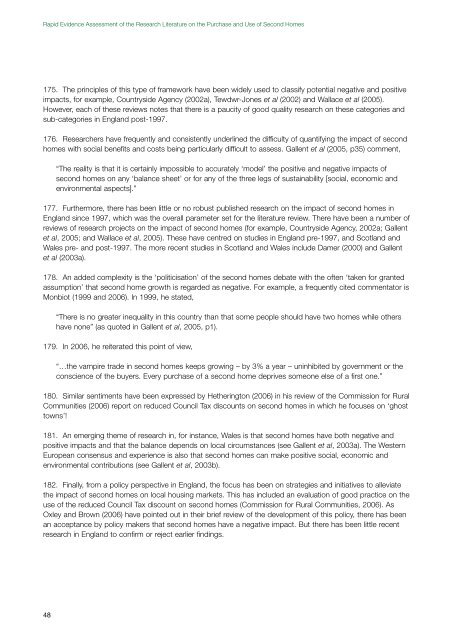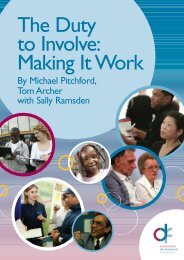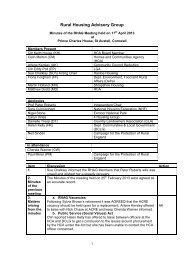Rapid Evidence Assessment of the Research ... - Rural Housing
Rapid Evidence Assessment of the Research ... - Rural Housing
Rapid Evidence Assessment of the Research ... - Rural Housing
Create successful ePaper yourself
Turn your PDF publications into a flip-book with our unique Google optimized e-Paper software.
<strong>Rapid</strong> <strong>Evidence</strong> <strong>Assessment</strong> <strong>of</strong> <strong>the</strong> <strong>Research</strong> Literature on <strong>the</strong> Purchase and Use <strong>of</strong> Second Homes<br />
175. The principles <strong>of</strong> this type <strong>of</strong> framework have been widely used to classify potential negative and positive<br />
impacts, for example, Countryside Agency (2002a), Tewdwr-Jones et al (2002) and Wallace et al (2005).<br />
However, each <strong>of</strong> <strong>the</strong>se reviews notes that <strong>the</strong>re is a paucity <strong>of</strong> good quality research on <strong>the</strong>se categories and<br />
sub-categories in England post-1997.<br />
176. <strong>Research</strong>ers have frequently and consistently underlined <strong>the</strong> difficulty <strong>of</strong> quantifying <strong>the</strong> impact <strong>of</strong> second<br />
homes with social benefits and costs being particularly difficult to assess. Gallent et al (2005, p35) comment,<br />
48<br />
“The reality is that it is certainly impossible to accurately ‘model’ <strong>the</strong> positive and negative impacts <strong>of</strong><br />
second homes on any ‘balance sheet’ or for any <strong>of</strong> <strong>the</strong> three legs <strong>of</strong> sustainability [social, economic and<br />
environmental aspects].”<br />
177. Fur<strong>the</strong>rmore, <strong>the</strong>re has been little or no robust published research on <strong>the</strong> impact <strong>of</strong> second homes in<br />
England since 1997, which was <strong>the</strong> overall parameter set for <strong>the</strong> literature review. There have been a number <strong>of</strong><br />
reviews <strong>of</strong> research projects on <strong>the</strong> impact <strong>of</strong> second homes (for example, Countryside Agency, 2002a; Gallent<br />
et al, 2005; and Wallace et al, 2005). These have centred on studies in England pre-1997, and Scotland and<br />
Wales pre- and post-1997. The more recent studies in Scotland and Wales include Damer (2000) and Gallent<br />
et al (2003a).<br />
178. An added complexity is <strong>the</strong> ‘politicisation’ <strong>of</strong> <strong>the</strong> second homes debate with <strong>the</strong> <strong>of</strong>ten ‘taken for granted<br />
assumption’ that second home growth is regarded as negative. For example, a frequently cited commentator is<br />
Monbiot (1999 and 2006). In 1999, he stated,<br />
179.<br />
“There is no greater inequality in this country than that some people should have two homes while o<strong>the</strong>rs<br />
have none” (as quoted in Gallent et al, 2005, p1).<br />
In 2006, he reiterated this point <strong>of</strong> view,<br />
“…<strong>the</strong> vampire trade in second homes keeps growing – by 3% a year – uninhibited by government or <strong>the</strong><br />
conscience <strong>of</strong> <strong>the</strong> buyers. Every purchase <strong>of</strong> a second home deprives someone else <strong>of</strong> a first one.”<br />
180. Similar sentiments have been expressed by He<strong>the</strong>rington (2006) in his review <strong>of</strong> <strong>the</strong> Commission for <strong>Rural</strong><br />
Communities (2006) report on reduced Council Tax discounts on second homes in which he focuses on ‘ghost<br />
towns’!<br />
181. An emerging <strong>the</strong>me <strong>of</strong> research in, for instance, Wales is that second homes have both negative and<br />
positive impacts and that <strong>the</strong> balance depends on local circumstances (see Gallent et al, 2003a). The Western<br />
European consensus and experience is also that second homes can make positive social, economic and<br />
environmental contributions (see Gallent et al, 2003b).<br />
182. Finally, from a policy perspective in England, <strong>the</strong> focus has been on strategies and initiatives to alleviate<br />
<strong>the</strong> impact <strong>of</strong> second homes on local housing markets. This has included an evaluation <strong>of</strong> good practice on <strong>the</strong><br />
use <strong>of</strong> <strong>the</strong> reduced Council Tax discount on second homes (Commission for <strong>Rural</strong> Communities, 2006). As<br />
Oxley and Brown (2006) have pointed out in <strong>the</strong>ir brief review <strong>of</strong> <strong>the</strong> development <strong>of</strong> this policy, <strong>the</strong>re has been<br />
an acceptance by policy makers that second homes have a negative impact. But <strong>the</strong>re has been little recent<br />
research in England to confirm or reject earlier findings.






